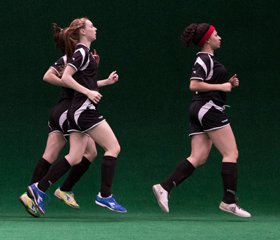The clothing in The Wolves consists mostly of high-school girls’ soccer uniforms. I asked Ásta Bennie Hostetter, the production’s costume designer, how they came about. “The joy in doing a uniform is that it has to be right,” she replied, “so I had to do my research. Particularly because, unlike the rest of the production’s creative team, I never played the sport.”
Hostetter researched the history of the uniforms: how things like shin guards have changed over the past 15 years – they’re now detachable. She added: “I also became aware of the degree to which the uniforms used with school teams and with soccer clubs relates to the resources that parents bring to the league. The kind of equipment and uniforms reflects how privileged a community is.”
Laura Jellinek, the set designer of The Wolves, had already told me why the uniforms changed from the dark-green of the earlier production to the black in the Mitzi E. Newhouse. (Much more green turf on the Newhouse set, plus the green of the theater’s seats, made for an overdose of the color.)
Hostetter acknowledged that explanation, and furnished details about what else had evolved. “When we did the first workshop, the players wore track suits. But changing out of them meant taking too much of a breath – it’s so important for the play to trot along very quickly.”
Hostetter, who grew up in New York and as a teenager went to the same school, Hunter College High, as director Lila Neugebauer, mentioned one of the primary pleasures of costume design. “You are such a bridge between the actors and the production team. You’re second to the director in terms of the number of interactions you have with the actors. That’s very satisfying.”
There are already at least two productions of The Wolves up outside New York. “There will be many more,” Hostetter said, “because it’s so rare to have a story that features so many parts for young women.” “I didn’t know much that was missing in our theater community until I watched other actors in the audience of the show. You can see it in their faces, which say: ‘I wish this would have existed – to be a high-school girl really tearing it up -- when I was the right age to be in it.’”
Hostettter explained that “the play has an emotional complexity, even as its terms are simple. That means that each community may do it very differently than we have done it, including in the color and details of the costumes.”
An alumna of The University of Chicago, Hostetter said she has long dreamed – and dreams still – of being like another graduate of that school: Susan Sontag. But Hostetter finds that some of the critical acumen associated with Sontag is present in theater work: “I still read stories and analyze structure.”
Hostetter said that The Wolves is “one of the best-structured new plays I’ve ever worked on.” She was aware of the talent of Sarah DeLappe, The Wolves’s playwright, from a previous collaboration. “I worked with Sarah on a 15-minute play of hers with my director friend Morgan Green.” As for Neugebauer, Hostetter said they have worked together at least five times, apart from strictly educational productions. One of those collaborations is the acclaimed Miles for Mary. Devised by The Mad Ones, a New York-based company of which Neugbauer is co-artistic director and Hostetter is a company member, Miles for Mary will move from off-off Broadway to Playwrights Horizons in January.
Before our interview ended, Hostetter said, “I want to make sure to point out something obvious but crucial about the costumes in The Wolves. The most powerful thing about them is that, because each woman wears the same thing, it takes the focus off the clothes and onto the characters. It’s rare to see that.”
Brendan Lemon is the editor of lemonwade.com.
